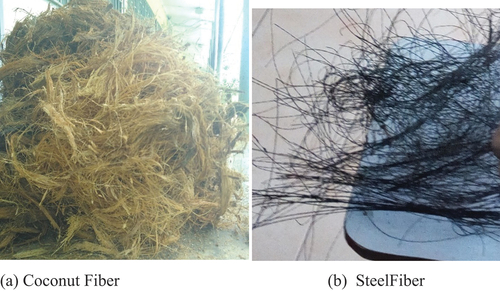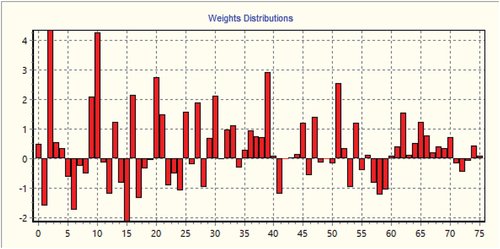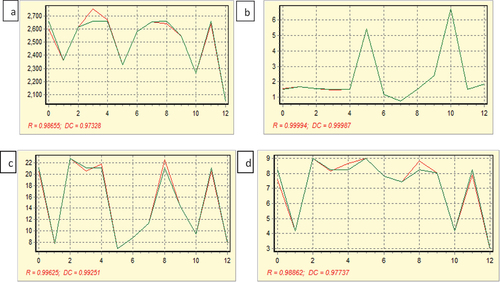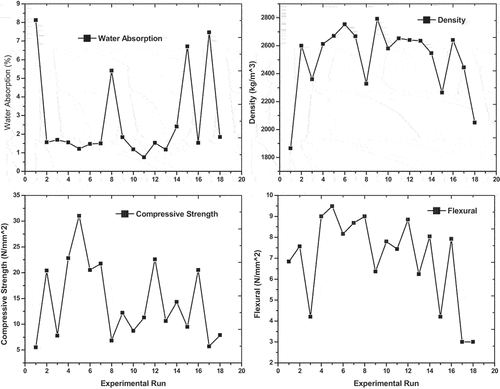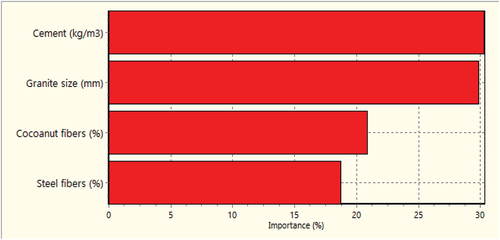Abstract
Fibre-Reinforced Concrete (FRC) has significant benefits due to its ability to improve the tensile and flexural strengths of hardened concrete. This study aimed to investigate the use of Artificial Neural Network (ANN) to predict and optimize coconut husk fibers and recycled tyre steel fibers reinforced concrete in terms of compressive and flexural strengths, density, and water absorption. A laboratory experiment of eighteen (18) different mix proportions was carried out with the volumetric fraction of the fibers varied between 0% and 2%. A quick propagation neural network that uses a supervised learning algorithm and feed-forward architecture was used for training and testing experimental data. The comparison of measurements between the experimental and ANN led to an accurate determination of compressive and flexural strengths as well as density and water absorption. The performance of the ANN was statistically measured using Root Mean Squared Error (RMSE), Mean Percentage Error (MPE), and Absolute Average Error (AAE) showing that the results are reliable. The performance of the ANN model was further evaluated using the absolute relative percent errors (PE). The values of PE obtained were 3.82032 and 12.4481, 3.63029, and 9.27939 for density, water absorption, compressive strength, and flexural strength respectively. An optimum combination of 500 kg/m3 for cement content, 25 mm for granite size, 0.92% for steel fibers, and 1.08% for coconut fibers was achieved by the Genetic Algorithm tool of ANN. The optimal value predicted for the outputs was also validated with experimental work and was found to be adequate. This strongly suggests that ANN can understand the existing relationship between the input variables and the output and is therefore recommended for the prediction and evaluation of fiber-reinforced concrete containing steel and coconut fibers.
1. Introduction
About fifteen thousand hectares of land are estimated to be under coconut cultivation in Nigeria, and another 1.2 million hectares have been identified to be suitable for coconut cultivation (Okwuagwu, Citation2005). However, an increase in coconut plantation has the potential to produce electricity, heat, organic fertilizer, health drinks, eco-friendly cutlery, etc. (Zafar, Citation2020). However, it is expected that an increase in coconut cultivation will also lead to an increase in waste generation. The coconut fruit yields 40% coconut husk containing 30% fiber and 10% dust. The husk is considered as the waste component obtained from coconut fruit and it has a chemical composition of cellulose, lignin, pyroligneous acid, gas, charcoal, tannin, and potassium (Zafar, Citation2020). The fiber and dust component of coconut husk has been identified to have good resistance to bacteria and fungi. To handle and manage the coconut husk waste generated, it has been used as a traditional source of fuel. Another way to utilize coconut husk is to incorporate the fiber component into the concrete mix in the form of discontinuous fibers to enhance concrete performance (Ede & Agbede, Citation2015).
Another solid waste of interest used in this study is waste tyres. These are tyres that are no longer able to perform the original function for which it was manufactured, hence discarded. However, in a developing country, such as Nigeria with inadequate landfills, discarded tyres are introduced into the environment without conscious effort to manage them. This contributes to environmental pollution, which has been a recurring issue preventing the attainment of a sustainable environment (Awolusi et al., Citation2019). All forms of vehicular movement, ranging from bicycles, tricycles, cars, vans, trucks, etc., require the use of tyres that are susceptible to wear and tear. According to the foraminifera market research, about 259 million tyres are discarded annually in Nigeria. This number is likely to increase due to the increase in the number of road motor vehicles. The prospect of using waste tyres as a source of fuel is undermined by high initial costs as well as environmental pollution resulting from the emission of carbon dioxide. Another method of reuse is the pyrolysis process, which produces carbon black that is both expensive and inferior to that obtained from petroleum. However, the use of waste tyres in concrete production has contributed significantly towards achieving sustainability in the construction industry. They can either be integrated as aggregate constituent material in the form of crumbs or by extracting the steel component to produce short discontinuous fibers serving as reinforcements in concrete (Awolusi et al., Citation2019a; Centonze et al., Citation2012; Gupta et al., Citation2015).
The use of fibers in concrete helps to prevent cracking caused by both plastic and drying shrinkage (Rahmani et al., Citation2012; Sangeetha & Shanmugapriya, Citation2020). They also aid in reducing the permeability of concrete, hence reducing water bleeding (Ahmad et al., Citation2020). However, optimizing and improving fibers in concrete, as well as better understanding their behavior, typically necessitates sophisticated experimental work that might be difficult to run effectively. According to Açikgenç et al. (Citation2015), to achieve the necessary quality, fiber-reinforced concrete takes more trial combinations than ordinary concrete. As a result of this complexity associated with carrying out large experimental programs in fiber reinforced concrete and significant inaccuracies and approximations coming from the available numerical approaches, artificial neural networks (ANN) have been developed as a viable prediction tool (Congro et al., Citation2021) and can be utilized for the fiber reinforced concrete mix design (Açikgenç et al., Citation2015).
ANN as a modeling technique provides an excellent alternative approach to model numerical data. The vast application of ANN in engineering and other disciplines against other conventional modeling techniques can be attributed to the ability of ANN to understand the relationship behind complex processes. It has the ability to learn from examples through iteration and does not require prior knowledge of the relationship between variables under investigation (Awolusi et al., Citation2019a; Awolusi et al., Citation2019b). The network is structured similarly to that of a biological network in an attempt to copy the neurological process, which occurs in the human brain (Ghoushchi, Citation2015). Generally, ANN is made up of an input layer of neurons (nodes), one or several hidden layers of neurons, and an output layer of neurons. Layers between the input and output layers are called hidden layers and may contain a large number of hidden processing units. The adjoining layers are fully interconnected by weights (coefficients). Information fed into the input layer neurons is transmitted into the neurons of the hidden layer without performing any calculations (Muthupriya et al., Citation2011), and the network predictions are broadcast to the outside world via the output layer neurons. Each neuron in a layer other than the input layer computes a linear combination of the outputs of the preceding layer’s neurons plus a bias at first. The weights determine the coefficients of the linear combinations plus the bias. In a related study, Oyejobi et al. (Citation2020) employed a central composite design tool to modify mix proportions using Design of Experiment (DOE) for the prediction of compressive strength of light-weight concrete. DOE was able to learn the relationship and inter-dependence of the mixed constituents.
A few studies have also been carried out using ANN as a prediction and optimization tool in conventional concrete (BoukliHacene et al., Citation2014; Chopra et al., Citation2015; Congro et al., Citation2021; Muthupriya et al., Citation2011; Nguyen et al., Citation2021; Torre et al., Citation2015). Hence, the study explores the possibility of utilizing the ANN techniques in evaluating the performance of concrete reinforced with discontinuous fibers obtained from waste materials. The utilization of waste materials such as coconut fibers and steel fibers from discarded tyres can promote environmental sustainability since the concrete produced will be eco-friendly. The study is aimed at determining the actual combination of coconut and steel fibers as reinforcement in concrete. In order to achieve this, several experiments were carried out by simultaneously varying the input parameters including cement content, granite size, steel fiber content, and coconut fiber content to determine the effect on the considered output parameters: density, water absorption, compressive strength, and flexural strength.
2. Materials and methods
2.1. Material constituents
2.1.1. Cement
The cement used in the study was grade 42.5 N Dangote brand of Portland limestone cement (PLC) available in the local market.
2.1.2. Aggregates
Three different grading of coarse aggregates were used to investigate the influence of coarse aggregates’ size. The first grade passed through the 10 mm sieve size. The second grade passed through 20 mm, while the third grade passed through a 25-mm sieve size. The fine aggregate was sharp sand passing through the 4.75 mm sieve.
2.1.3. Fibers
Both natural and steel fibers obtained from coconut and tyre waste, respectively, were incorporated into the concrete mix. The coconut fibers were obtained from the outer husk of the coconut. The coconut fibers varied in diameter and length. The diameter varied between 0.2 mm and 0.3 mm, while the length varied between 100 mm and 150 mm. Steel fibers were obtained by shredding scrap tyres. Using the cutting disk, the steel fibers were chopped to a length of 30 mm with diameters ranging from 0.25 mm to 0.6 mm. A volumetric proportion of 2% was used to keep the number of fibers added to the concrete mix constant. Coconut fibers were incorporated into the concrete mix in the form of macrofibers, while steel fibers served as microfibers. The two fibers used in this study are shown in Figure .
2.1.4. Water
Potable water available in the laboratory was used for mixing and curing of concrete.
2.1.5. Superplasticizer
To improve the workability of the fresh concrete mix, the Sulphonated Naphthalene Formaldehyde (SNF) condensate type of super-plasticizer produced by Advanced Concrete Technology Limited, Lagos State Nigeria was applied. The superplasticizer was added to all the mixes at 1.5% by weight of cement.
2.2. Experimental procedure
A laboratory mixer with a 60-revolution-per-minute mixing speed was used to mix the concrete. Before adding the fibers, the cement and aggregate were mixed together first. After that, water mixed with superplasticizer was added to the mix before the fibers were added. The mixing was done using a constant water–cement ratio of 0.27. According to the flow chart in Figure , the concrete mixing time for each batch (run) was about 4–6 minutes. Table shows the exact proportions of each combination in kilograms per cubic meter. For density, water absorption, and compressive strength test, freshly made concrete was poured into lubricated 100 mm cube moulds, whereas the 400 mm by 100 mm by 100 mm cube moulds were used for flexural strength. To ensure uniform compaction, each mould was filled in three layers, with each layer receiving 35 strokes of 16 mm steel tampering rod. After 24 hours, the specimens were wrapped with damp sacks and demoulded. Water was used to cure all of the specimens for a total of 28 days. Flexural and compressive strength testing was carried out in line with the relevant standards (BS EN 12350–2:2009; BS EN 12390–3:2009). All data obtained are an average of three specimens.
Table 1. Concrete mix proportion
2.3. Artificial neural network
Due to its capacity to use learning algorithms and identify input-output linkages for complicated, non-linear systems, Artificial Neural Networks (ANN) have been increasingly used as a tool for prediction in a wide range of disciplines, including engineering (Awolusi et al., Citation2019a; Pilkington et al., Citation2014). Figure depicts the multilayer normal feed-forward connection type used in this work, which includes the input, hidden, and output layers. The following conditions determine the number of neurons in each layer:
The number of neurons in the input layer is a function of the number of independent variables considered in the study, which are cement content, percentage steel fiber, and aggregate size and percentage coconut fiber;
A trial and error method is used to identify the number of neurons in the hidden layer. The selected number of neurons chosen is determined by the least Root Mean Square Error (RMSE) attained during the training process;
The amount of neurons in the output layer is determined by the study’s response/properties. Water absorption, density, water absorption, flexural strength, and compressive strength are only a few of these characteristics.
The research used a total of 18 experimental data sets, 13 of which were used for training and the remaining 5 for testing. The network architecture is illustrated in Figure . The quick propagation algorithm consists of four neurons in the input layer, a single hidden layer of eight neurons, and four neurons in the output layer shown as color black, yellow, and blue, respectively (see, Figure ). Although deciding on the number of hidden layers can be difficult, however, Hush and Horne (Citation1993) state that in most cases, no more than one hidden layer is employed in a network. In addition, the hidden and output layers’ transfer functions were sigmoid and Tanh, respectively. Through repeated weight adjustment, the neural network was trained to match the set of input data given into the network. Figure shows the weight varied between −2.134 and 4.336 with only a few bars close to zero. The network was trained with the training set, and the test set maintained the level of generalization and monitoring of overtraining for the training set in check. The network calculates the associated Root Mean Square Error (RMSE) for the training and testing data sets. When a minimum RMSE for test set prediction is attained, training automatically ends (Awolusi et al., Citation2019a). The success of the learning process is measured by the system’s performance on test data. The performance of the ANN was statistically measured by RMSE, Mean Prediction Error (MPE). In addition, Average Absolute Error (AAE) was also used to evaluate the model performance.
The lower and upper limit values for the input variables, output variables, and weights for all properties investigated are presented in Table . The ability of the ANN to match with the experimentally obtained data is presented in Figure showing experimental data (in colour green) and the ANN trained network (in colour red) for density, water absorption, compressive strength, and flexural strength, respectively. From these figures, it was observed that the ANN predictions were close to that of the experimental data. This means that, regardless of the experimental design utilized, ANN can grasp the existing relationship between the input variables and the qualities (responses) being explored.
Table 2. Data used in training and testing the ANN model
3. Results and discussion
3.1. Effects of fibers contents on the properties of concrete
The results of an experimental investigation to study the effects of different fiber types and contents on the properties of concrete are presented in Figures . From Figure , it can be seen that there is a variation in the density, water absorption, compressive strength, and flexural strength properties of the concrete containing the different fiber types and content. Various studies have reported this variation, which can also be explained by the fact that air trapped around the fibers reduces the strength (Pilakoutas et al., Citation2004; Zeyad, Citation2020). However, it was observed from the results that experimental runs 1 and 11 having coarse aggregate size increased from 10 mm to 20 mm with the same cement content of 500 kg/m3, steel fiber of 0% and coconut fiber 2% showed an increase in density, compressive and flexural strengths from 1865 to 2653 kg/m3, 5.52 to 11. 32 N/mm2and 6.84 to 7.44 N/mm2. The increase in density and strength is accompanied by reduced water absorption from 8.12% to 0.76%. A further strength and density increase was observed by comparing the aforementioned experimental runs with run 6 containing the same cement content with aggregate size increased from 20 to 25 and equal fiber content of 1% for both coconut and steel fibers. Furthermore, the highest strength in terms of compressive and flexural was obtained for mix 5 with 500 kg/m3of cement,20 mm coarse aggregate size, 2% steel fibers, and 0% coconut fibers. The increase in the strength may be attributed to larger coarse aggregates size with higher contents of coarse aggregates, which forms the skeleton structure for the concrete. This increase in strength due to aggregates size is in agreement with the study conducted by Kang and Weibin (Citation2018) and Musa and Bin Saim (Citation2017).
3.2. ANN analysis
Table shows the statistical measures and performance index for the four attributes studied with the rapid propagation learning technique. The precision and bias were assessed using the test set’s RMSE and MPE, respectively. The ANN model’s ability to predict was tested using five test data sets for each property evaluated. The values obtained for RMSE, MPE, and AAE (see, Table ) for the test set were relatively low for density, water absorption, compressive strength, and flexural strength. The result signifies a good accuracy of the ANN in predicting all properties investigated in the study. The finding of this study is further corroborated by previous studies, which identify the strength and superiority of ANN over most modeling techniques and also suggest the ability of ANN to predict response without prior knowledge of variables being investigated (Awolusi et al., Citation2019a; Muthupriya et al., Citation2011).
Table 3. Performance index of ANN model
3.3. ANN Analysis of relative importance
In this study four input parameters were considered, this includes the cement content, granite size, percentage of coconut fiber, and percentage of steel fiber. The role played by each parameter in influencing a change in output is displayed in Figure . From this figure, it was observed that cement content played the most significant role; this is closely followed by the granite size with coconut fiber next in line and lastly steel fiber. The cement content identified as the most significant parameter influencing all responses can be attributed to the fact that the binding of the other constituent of the concrete depends on cement. The coarse aggregate size also played a major role in determining the response. This could be attributed to the fact that the coarse aggregate occupies the highest volume from the mix proportioning of constituent materials considered in the study. Among other factors, aggregate size has been identified as one of the factors that affect concrete workability, strength, and durability. In addition, the cement content and the granite size are closely related since the smaller the aggregate size, the more the cement required for coating. For the fibers, the order of importance reflects that coconut fiber played a slightly significant role than steel fiber which implies that the role of coconut fibers as a macro fiber in the concrete mix was more pronounced than that of the steel fibers as microfiber.
3.4. Optimization using ANN
For optimization, the Genetic Algorithm tool, which is a type of optimal algorithm, was utilized. The population size, mutation rate, crossover-type, and selection type used were 30, 0.8, 0.1, uniform crossover, and absolute top-mate selection, respectively. The details of the optimal values obtained for input and output parameters are presented in Table . It was observed that the model prediction corroborates the relative importance of the input parameter presented in Figure . Figures earlier identified coconut fiber to be played a slightly more significant role than steel fiber, and from Table , it was observed that the quantity of steel fiber was 0.92, while coconut fiber was 1.08. To assess the predictive ability of the ANN model, a laboratory experiment was conducted using the given optimal values for the input parameters. From the results obtained, it was observed that the experimental results were close to those predicted by the models. The performance of the ANN model was further evaluated using the absolute relative percent errors (PE). The values of PE obtained were 3.82032 and 12.4481, 3.63029, and 9.27939 for density, water absorption, compressive strength, and flexural strength, respectively. Because the PE values obtained were so low, it was possible to conclude that the model accurately predicted the desired responses. In general, the process considered all investigated properties simultaneously to achieve a common goal and through the optimization process, the study has been able to identify the proportions of input parameters that enhance the output parameters.
Table 4. Optimum conditions achieved for fiber reinforced concrete
4. Conclusions
This study has carried out an experimental investigation of coconut husk fibers and recycled tyre steel fibers reinforced concrete. The laboratory result was further evaluated by using an artificial neural network approach. Hence, the following inferences are made from the study:
The incorporation of recycled tyre steel fibers and coconut husk fibers contribute immensely to the mechanical properties of the concrete and environmental sustainability.
Having learned from the training, ANN has been demonstrated as a vital tool for complementing laboratory results. The tool has the capability for accurate prediction with low values of RMSE, MPE, and AAE.
Depending on the concrete mix proportions, the density of the concrete ranges between 1865 and 2793 kg/m3, water absorption is between 0.76% and 8.12%, compressive strength is between 5.52 and 22.80 N/mm2, and flexural strength between 3.00 and 9.48 N/mm,2 respectively.
At a constant water–cement ratio of 0.27, the most significant input variables, which influence the output are cement and granite, while coconut husk fibers take a marginal lead over steel fibers.
The optimization of the input variables to achieve better output signifies a combination of 500 kg/m3cement content, 25 mm granite size, 0.92% steel fiber, and 1.18% coconut fiber.
The study is limited to evaluating the mechanical properties of concrete incorporation of steel fibers and coconut husk fibers on a short-term basis. In addition, the predicted values signify these experimental values that can be derived using ANN, and the generated models are only applicable for the range of data used. Further study on the long-term mechanical properties beyond 28 days as well as its resistance to chemical attack and impact load can be carried out.
Disclosure statement
No potential conflict of interest was reported by the author(s).
Additional information
Funding
References
- Açikgenç, M., Ulaş, M., & Alyamaç, K. E. (2015). Using an artificial neural network to predict mix compositions of steel fiber-reinforced concrete. Arabian Journal for Science and Engineering, 40(2), 407–12. https://doi.org/10.1007/s13369-014-1549-x
- Ahmad, W., Farooq, S. H., Usman, M., Khan, M., Ahmad, A., Aslam, F., Sufian, M., Abduljabbar, H. A., & Sufian, M. (2020). Effect of coconut fiber length and content on properties of high strength concrete. Materials, 13(5), 1075. https://doi.org/10.3390/ma13051075
- Awolusi, T., Oke, O., Akinkurolere, O., & Sojobi, A. (2019). Application of response surface methodology: Predicting and optimizing the properties of concrete containing steel fibre extracted from waste tires with limestone powder as filler. Case Studies in Construction Materials, 10, e00212. https://doi.org/10.1016/j.cscm.2018.e00212
- Awolusi, A., Oke, O., Akinkurolere, O., Sojobi, A., & Aluko, O. (2019a). Performance comparison of neural network training algorithms in the modeling properties of steel fiber reinforced concrete. Heliyon, 5(1), e01115. https://doi.org/10.1016/j.heliyon.2018.e01115
- Awolusi, T., Oke, O., Akinkurolere, O., Atoyebi, O., & Bureerat, S. (2019b). Comparison of response surface methodology and hybrid-training approach of artificial neural network in modelling the properties of concrete containing steel fibre extracted from waste tyres. Cogent Engineering, 6(1). https://doi.org/10.1080/23311916.2019.1649852
- BoukliHacene, S., Ghomari, F., Schoefs, F., & Khelidj, A. (2014). Probabilistic modelling of compressive strength of concrete using response surface methodology and neural networks. Arabian Journal for Science and Engineering, 39(6), 4451–4460. https://doi.org/10.1007/s13369-014-1139-y
- Centonze, G., Leone, M., & Aiello, M. (2012). Steel fibers from waste tires as reinforcement in concrete: A mechanical characterization. Construction and Building Materials, 36, 46–57. Accessed 25 September 2020. ISSN 0950-0618. https://doi.org/10.1016/j.conbuildmat.2012.04.088
- Chopra, P., Sharma, R., & Kumar, M. (2015). Artificial neural networks for the prediction of compressive strength of concrete. ”International Journal of Applied Science and Engineering, 13(3), 187–204.
- Congro, M., de Alencar Monteiro, V. M., Brandão, A. L., Dos Santos, B. F., Roehl, D., & de Andrade Silva, F. (2021). Prediction of the residual flexural strength of fiber reinforced concrete using artificial neural networks. Construction and Building Materials, 303, 124502. ISSN 0950-0618. https://doi.org/10.1016/j.conbuildmat.2021.124502
- Ede, A. N., & Agbede, J. O. (2015). Use of coconut husk fiber for improved compressive and flexural strength of concrete. International Journal of Scientific and Engineering Research, 6(2), 968–974. http:/www.ijser.org
- Ghoushchi, S. J. (2015). Optimization of transportation system based on combined model using artificial neural networks and response surface methodology. International Journal of Technical Research and Applications, 23, 69–76.
- Gupta, T., Sharma, R., & Chaudhary, S. (2015). Impact resistance of concrete containing waste rubber fiber and silica fume. International Journal of Impact Engineering, 83, 76–87. https://doi.org/10.1016/j.ijimpeng.2015.05.002
- Hush, D., & Horne, B. G. (1993). Progress in supervised neural networks. IEEE Signal Processing Magazine, 10(1), 8–39. https://doi.org/10.1109/79.180705
- Kang, M., & Weibin, L. (2018). Effect of the aggregate size on strength properties of recycled aggregate concrete. Advances in Materials Science and Engineering, 2018, Article ID 2428576,1–8. https://doi.org/10.1155/2018/2428576
- Musa, M. F., & Bin Saim, A. A. (2017). The effect of aggregate size on the strength of concrete. the colloquium, 10, 9–11.
- Muthupriya, P., Subramanian, K., & Vishnuram, B. (2011). Prediction of compressive strength and durability of high performance concrete by artificial neural networks. International Journal of Optimization in Civil Engineering, 1(1), 189–209. http://ijoce.iust.ac.ir/article-1-15-en.html
- Nguyen, Q. H., Ly, H. B., Nguyen, T. A., Phan, V. H., Nguyen, L. K., Tran, V. Q., & Xie, T. (2021). Investigation of ANN architecture for predicting shear strength of fiber reinforcement bars concrete beams. Plos One, 16(4), e0247391. https://doi.org/10.1371/journal.pone.0247391
- Okwuagwu, C. O. (2005). Status of coconut genetic resources research in Nigeria. In Coconut genetic resources (pp. 667–669). The pacific and oceania.
- Oyejobi, D., Jameel, M., Sulong, N., Raji, S., & Ibrahim, H. (2020). Prediction of optimum compressive strength of light-weight concrete containing Nigerian palm kernel shells. Journal of King Saud University - Engineering Sciences, 32(5), 303–309. https://doi.org/10.1016/j.jksues.2019.04.001
- Pilakoutas, K., Neocleous, K., & Tlemat, H. (2004, September). Reuse of tyre steel fibres as concrete reinforcement. Proceedings of the Institution of Civil Engineers-Engineering Sustainability, 157(3), 131–138. Thomas Telford Ltd. https://doi.org/10.1680/ensu.2004.157.3.131
- Pilkington, J., Preston, C., & Gomes, R. (2014). Comparison of response surface methodology (RSM) and artificial neural networks (ANN) towards efficient extraction of artemisinin from Artemisia annua. Industrial Crops and Products, 58, 15–24. ISSN 0926-6690. https://doi.org/10.1016/j.indcrop.2014.03.016
- Rahmani, T., Kiani, B., Bakhshi, M., & Shekarchizadeh, M. (2012). Application of different fibers to reduce plastic shrinkage cracking of concrete. In 7th RILEM International Conference on Cracking in Pavements (pp. 635–642). Springer, Dordrecht.
- Sangeetha, P., & Shanmugapriya, M. (2020, December). Artificial neural network applications in fiber reinforced concrete. Journal of Physics: Conference Series, 1706(1), 012113. IOP Publishing. https://doi.org/10.1088/1742-6596/1706/1/012113
- Torre, A., Garcia, F., Moromi, I., Espinoza, P., & Acuña, L., “Prediction of compression strength of high performance concrete using artificial neural networks”, Journal of Physics: Conference Series, vol. 582, p. 012010, 2015. https://doi.org/10.1088/1742-6596/582/1/012010.
- Zafar, S. 19 January 2020. Energy potential of coconut biomass. BioEnergy Consult. [Retrieved: 25-September-2020] from. http://www.bioenergyconsult.com/tag/uses-of-coconut-wastes/
- Zeyad, A. M. (2020). Effect of fibers types on fresh properties and flexural toughness of self-compacting concrete. Journal of Materials Research and Technology, 9(3), 4147–4158. https://doi.org/10.1016/j.jmrt.2020.02.042

